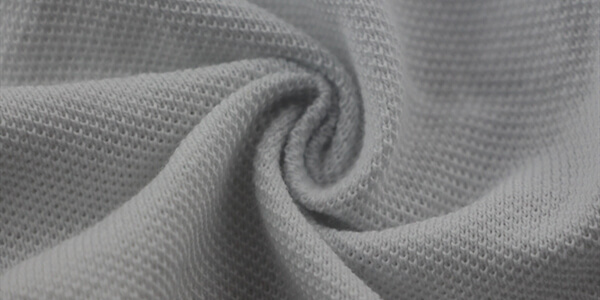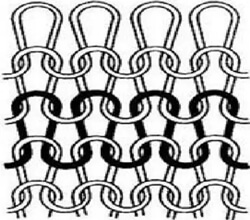
Explorando os vários estilos de tecidos de malha
O tricô é uma forma de manipulação de fios em que os laços são entrelaçados para criar tecidos ou tecidos. Este tipo de tecido consiste em linhas horizontais conhecidas como cursos e linhas verticais referidas como wales. Os tecidos de malha são usados em vários itens do dia a dia, desde roupas até roupas de cama.
O processo de tricô requer manipulação cuidadosa dos loops de fios. Para criar o tecido, é preciso puxar loops consecutivos através do loop de uma linha anterior. Essa ação intermediária forma uma série de loops conectados que produzem o material de malha.
Os tecidos de malha são famosos por roupas, cobertores e outros itens que requerem calor ou flexibilidade. O tricô é apenas um tipo de estrutura de tecido; Tecidos tecidos, não tecidos e trançados também são padrão. Cada um tem sua aparência e sensação distintas, vantagens e desvantagens. O tipo de tecido que você seleciona depende do que você está criando e do resultado desejado. Conhecer os diferentes tipos de materiais disponíveis pode ajudá -lo a tomar uma decisão informada.
1. Tecidos de malha de trama
Os tecidos tricotados de trama são geralmente compostos de várias matérias-primas, como fios de algodão, fios misturados, seda de poliéster de baixa elasticidade ou seda de poliéster de formato particular, seda de náilon, fios de algodão, fios de lã e seda de spandex. Esses materiais são tecidos usando vários métodos, incluindo organização de ponto simples (contendo malha básica, ponto simples de troca, ponto canelado simples e ponto simples com nervura dupla), organização jacquard e organização circular de lã. Elasticidade, maciez, resistência a rugas e textura tipo cabelo são características padrão dos tecidos de malha de trama. Tecido de malha de trama de algodão tem boa absorção de umidade e permeabilidade ao ar; no entanto, o material não é nítido e tende a enrugar e soltar. Por outro lado, o tecido tricotado com fibras químicas tem maior probabilidade de obter penugem, bolinhas ou fios de seda.

As principais categorias de tecidos de malha de trama são as seguintes:
Tecido de malha de poliéster
Este tecido combina com roupas masculinas, femininas e infantis. É um material altamente resistente a desgaste e elástico, com grande apelo visual. Possui uma estrutura compacta e espessa, tornando -o ideal para jaquetas, ternos, roupas esportivas, roupas de ioga, roupas ao ar livre, quebra -vento, coletes, saias e outras roupas. O tecido apresenta cores brilhantes e texturas nítidas que se assemelham aos estilos de tweed de tecido de lã. A coordenação de cores é harmoniosa e os detalhes da tecer são claros e distintos.
Tecido de malha de algodão
Uma escolha popular em muitos tipos de roupas e acessórios. Pode ser encontrado em roupas como camisetas, roupa de baixo, desgaste casual, jaquetas, ternos, casacos e até roupas infantis. Esse tipo de tecido é conhecido por sua textura suave e sensação de gordura. Também tem boa elasticidade e capacidade de manter o calor. Os tipos populares de tecido de algodão de malha incluem pano liso, pano de suor, algodão mercerizado, pano de capuz, camada de ar, pano romano e pano de dupla face. Esses tecidos são de excelente qualidade, tornando -os ideais para vários itens de roupas.
Capa de poliéster tecido de malha de algodão
O tecido, criado a partir de uma mistura de poliéster e algodão, é ideal para criar camisas, jaquetas e roupas ativas. Suas fibras resistentes a rugas tornam incrivelmente fácil de cuidar, e sua composição resistente ao desgaste permite um uso duradouro. Também é altamente respirável, tornando -o confortável quando usado contra a pele. Além disso, é suave ao toque, tornando -o uma excelente opção para roupas. O tecido também é tingido em uma variedade de cores e tons.
Tecidos de fibra de celulose reciclada
Eles são uma escolha popular para roupas e incluem tecido tencel, tecido modal, tecido de fibra de bambu, tecido de viscose e tecido de amônia de cobre. Esses tecidos são macios, com boas propriedades de retenção de calor e alto brilho. Romas de malha como camisetas, roupas íntimas, leggings e saias são frequentemente feitas com esses tecidos. Suas qualidades leves, porém duráveis, tornam -as uma excelente opção para o desgaste diário. Vários materiais permitem que os designers criem looks únicos para se adequar a qualquer estilo ou ocasião. Os tecidos de fibra de celulose reciclados podem ser facilmente lavados e mantidos para manter as roupas que parecem novas nos próximos anos. Esses tecidos podem fornecer uma aparência luxuosa com os cuidados adequados. Eles também são mais amigáveis ao meio ambiente que os tecidos tradicionais, tornando-os uma escolha cada vez mais popular para os consumidores conscientes da moda.
2. Tecidos de malha
Os tecidos triturados são geralmente feitos de materiais de filamentos sintéticos como poliéster, nylon, vinilon e polipropileno. Como alternativa, eles podem ser construídos com fibras naturais como algodão, lã, seda ou cânhamo misturadas com fibras químicas. Esse tipo de tecido oferece boa estabilidade longitudinal, uma sensação nítida e menos dispersão. A permeabilidade ao ar também é boa, mas sua extensão lateral, elasticidade e suavidade são mais fracas que os tecidos triturados.
Os tecidos triturados são altamente duráveis e ideais para tecidos técnicos e médicos, roupas de proteção e interiores automotivos. O tricô de urdidura tem muitas aplicações práticas na indústria têxtil devido às suas características únicas. É comumente usado para fazer lingerie, meias, fitas decorativas, enfeites, roupas de banho e estofados. Também é usado como reforço em produtos de borracha, como pneus e mangueiras.
O tricô de urdidura é muito mais rápido que o tricô, porque não reinserta o fio no tecido de malha. Isso significa tempos de produção mais curtos e economia de custos para os fabricantes, tornando o tricô de malha uma escolha popular para a produção em larga escala. Os materiais também podem ser manipulados para criar padrões complexos com mais controle do que outros tipos de tricô. O tricô tornou -se essencial em muitas indústrias, e os avanços tecnológicos continuam a levar a novas possibilidades.
As principais categorias de tecidos triturados são os seguintes:
Tecido triturado de poliéster
Uma escolha popular para vestuário devido à sua textura plana e cores brilhantes. Geralmente vem em dois pesos; fino e grosso. Os tecidos triturados de poliéster leves são frequentemente usados para fazer camisas e saias, enquanto materiais médios e espessos podem ser usados para outras roupas, como jaquetas, casacos, ternos, calças e muito mais.
Tecido de malha de malha.
Este tecido é comumente usado para produzir roupas de inverno, como casacos de homens e mulheres, casacos, jaquetas e calças. Tem uma cortina agradável, é fácil de lavar, seca rapidamente e pode ser passada. No entanto, é propenso a acumulação estática e pode facilmente atrair poeira.
Além disso, quando usado com outros tecidos, como lã ou acrílico, sua propriedade estática aumenta, atraindo mais poeira. Para reduzir isso, acabamentos antiestáticos especiais podem ser aplicados ao tecido. Isso ajuda a protegê -lo da sujeira e da poeira, tornando o material mais durável e mais fácil de limpar.
Em conclusão, o tecido da pilha triturado é ideal para roupas de inverno devido à sua cortina superior, lavagem fácil, secagem rápida e capacidade de passar. Deve-se notar que é suscetível à acumulação estática e de poeira e, portanto, requer acabamento anti-estático especial ou outros tratamentos para reduzir isso.
Tecido de malha triturada
O tecido de malha com uma textura fina e excelente elasticidade apresenta um toque suave e suave. Também possui excelente permeabilidade ao ar, ideal para roupas de verão, como camisas masculinas e femininas. Sua natureza versátil o torna uma escolha popular entre designers e consumidores de moda.
Tecido de veludo triturado
A superfície do tecido de veludo triturada é espessa e macia, tornando-o incrivelmente macio. Suas as capacidades de elasticidade e retenção de calor o tornam uma escolha ideal para roupas de inverno e vestuário infantil. É um material luxuoso que fornece calor, conforto e classe. Sua pilha grossa acrescenta uma textura agradável a qualquer peça de roupa. Assim, está se tornando cada vez mais popular por sua versatilidade e elegância. Se você está procurando um casaco de inverno aconchegante ou um vestido de festa elegante, este tecido fará uma declaração. Sua textura suntuosa e sensação luxuosa tornam a escolha perfeita para qualquer ocasião.
Tecido de malha de malha.
Este tecido tem uma consistência completa e espessa, graças ao seu corpo sólido e flexível. É elástico, absorve bem a umidade e fornece um bom calor. É caracterizada por uma estrutura de loop estável e roupas superior e é usada principalmente para roupas esportivas, camisetas de lapela, pijamas e roupas infantis. Sua versatilidade o torna uma escolha popular para muitas aplicações de vestuário.
Os tecidos de malha são feitos de vários materiais, incluindo fibras naturais como algodão, cânhamo, seda e lã e fibras sintéticas como acrílico, poliéster e spandex. Tais tecidos apresentam boa elasticidade, absorção de umidade, calor e conforto. Eles têm uma grande variedade de padrões, cores e texturas. Os tecidos de malha podem ser classificados de acordo com os métodos de tecelagem, tingimento, acabamento e outros métodos de processamento. Cada tipo de tecido tem suas características únicas. Assim, os materiais de malha podem ser usados para vários tipos de vestuário para homens, mulheres e crianças.

